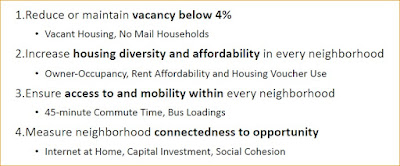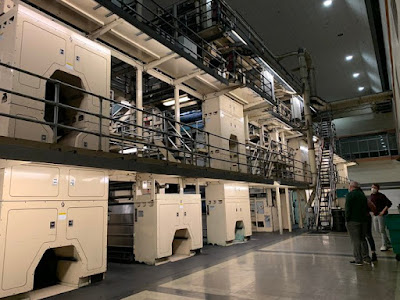Population growth as a remedy for Baltimore has been the topic of this blog for many years. (See here, here , here and here)). 20 years ago when I advanced the topic with then Mayor O'Malley growing Baltimore back to 850,000 residents, what seemed to be the "carrying capacity" of the city without massive new infrastructure or new high density zoning, seemed not too far fetched. But instead we lost another 66000 people.
The 2020 census tells us that pretty much every larger city in the northeast and across the nation gained population, but Baltimore lost 5.7% of its residents. Detroit, Milwaukee, and Memphis were the only other large cities in the loser camp. All surrounding areas in our metro region grew, Baltimore County surpassed the City in the 1990s. However, the picture isn't only bleak, a deeper look is warranted. (See this report)
Maybe it is comforting that the last 20 year loss is only half the one Baltimore experienced in the years between 1980 and 2000. Or, that the number of households in the City actually grew in the last decade by 1%; not much, but definitely not a loss. The reason for that surprising fact is simple: Households become ever smaller and so it is that there are now more occupied housing units than there were in 2010, just fewer people in them. There are other bright spots: In the last decade the City gained 24,473 primary jobs, (+ 8.3%), although, workers who live in the City do not necessarily work in Baltimore, but their number increased by 4.2% as well. Over half of the City’s workforce commutes into the City and more Baltimoreans work outside the City than live and work in the City. Asian origin rpopulation grew by 46%, Latino population by 77% but even combined represent merely around 12% of the overall population.
 |
| BNIA suggested growth strategies |
of all Baltimore st
Baltimore did not lose population across the board. 15 statistical areas (CSA) actually gained poplution, the CSA with the biggest gain is downtown (+47%). A pleasant brightspot is Barclay, a formerly invested Charles North/ Midtown community that saw growth on the basis of careful and well planned intervention and investment. In all three CSAs went from loss to gains: Greater Charles Village/Barclay, Orchard Ridge/Armistead and Southeastern. Meanwhile the Latino population grew by 77% during the decade and Greektown became a strong growth area.
The real problem is [that the] overall population loss in Baltimore was 52%. 10 times more than any other city except for New Orleans, but that is because of Katrina. Baltimore effectively suffered a cataclysmic event in terms of population loss on the scale of Katrina between 1990 and 2010, without the requisite reinvestment. We don’t have a gentrification problem. We have a lack of development problem Seema D. Iyer, PhD Baltimore Neighborhood Indicators Alliance—Jacob France Institute, UB
Anyone who has followed the maps of former Morgan University Professor Brown who now heads up the Black Butterfly Academy will not be surprised that once again the black butterfly neighborhoods are the victims: They lost more residents than any other neighborhood, led by Carrollton Ridge, where population decline in the decade was the steepest. The mapped result of population change once again gets us to the black butterfly shape already known from race, poverty and vacancy distribution and pretty much every other indicator.
What all this means is that not only are Baltimore's residents highly segregated by race and income, but the population loss is no longer caused by white flight. Instead, the City is losing black residents at a higher rate (-15%) than white residents (-11%). Poor black residents are no longer putting up with living in disinvested formerly re-lined communities. As soon as there is an opportunity, they will leave. In a vicious cycle, the vacant houses and the underutilized schools that are left behind will accelerate the exodus ahead.
The black flight is not surprising. Quality of life metrics measured by the Neighborhoods Indicator Alliance are clear indicators many changes of the decade are pointing in the wrong diection. For example health: The disparity in life expectancy from one census tract to another increased from a 19.4 year difference in 2012 to a whopping 21.5 years in 2018. Thus the zip code is a bigger determinant of one's life expectancy than one's DNA code! While the teen birth rate declined 60% in the last decade citywide, baby health is still an issue: The rate of babies born with a satisfactory birth weight remained nearly unchanged and is still under 90%, lower in poor neighborhoods.
BNIA known for its "vital signs reports" and the annual data day has looked deeper into the Baltimore Community Change 2010-20 and created six individual research reports which are worth studying. The above data are taken from those reports.
BNIA is no longer just amassing data, it is now intent on enabling social change. In a press release the university institute states:
Historians may well mark the decade that just passed as one of the most tumultuous for Baltimore. From the Great Recession to civil unrest after the death of Freddie Gray while in police custody, to the widespread problem of vacant houses and the COVID-19 pandemic, Baltimore's neighborhoods have been buffeted by multiple economic, political and public health storms. The challenge is how to leverage resiliency where it exists and capitalize on opportunities when they arise.
What can be done: BNIA will organize Baltimore's first. Community Change Summit during the week of March 21-26. All who are interested can attend a session to help in developing data-driven solutions together with the help of a graduate student team consisting of four students from Morgan State University, Johns Hopkins University, and the Universities of Michigan and Illinois, with various technical backgrounds in urban planning, communications, and public health. The effort is sponsored by the France-Merrick Foundation, the Greater Baltimore Committee and the Baltimore Community Foundation.
In a recent presentation Seema Iyer emphasized the importance of access and networks with which she meant that well connected neighborhoods have better home values and a better quality of life. She noted access to grocery stores, transit and jobs as well as education. The importance of those connections is beyond doubt. Asked whether the disconnectedness is the cause or the result of disinvestment and abandonment, Iyer responded to me that it mattered less what is cause and what effect than that the cycle is broken. Iyer sees the need for networking in broader terms, all the way to intentional and organized social contacts between communities and all efforts of building "social capital". She uses social theory when she speaks about "divergence" and how declining neighborhoods become isolated, "physically, digitally, socially and financially".
Grocery stores and schools close when population dwindles and clearly, the poorer and less educated the demographic profile of a community, the fewer available jobs there are in reach contributing to transit disconnectedness. 21% of City residents have a commute to work that is longer than 45 minutes, with Southern Park Heights leading the pack of the longest commutes (33% exceed 45 min.). This is especially hard for the nearly 30% of residents without access to a car, in several communities that share is between 50-60%. 17.5% of residents commute by transit citywide, but in many communities that share is between 30 to 40%, in Sandtown it is 60%. Iyer sees the problem not only as one of distance or of the service itself, but also as one of cost and is suggesting that the MTA and the City could create free boarding zones, especially on Baltimore's "main streets" which should be developed as community hubs where to find services, WiFi, free transit and amenities. She imagines that communities would flesh out some of these concepts tailored to their specific needs.
Council President Mosby re-introduced a Dollar House bill with the goal to lure low income residents to becoming homeowners in formerly redlined communities. Alas, the bill ran into heavy crossfire, not because fellow council members or Housing Commissioner Kennedy would be opposed to black homeownership, but because they question how much the envisioned $25,000 per buyer would do towards fixing houses up (a cost often exceeding $180,000) or getting a mortgage to cover the difference. Especially questionable: Is it right to lure low income home-buyers into heavily disinvested areas where the finished house value will exceed by far what the market will likely yield for many years to come. Thusly "under water" owners would be trapped in their house in the same way already existing homeowners in those areas are.
Overall, Baltimore has become a posterchild of the predicament that the entire nation will have to face sooner or later, namely that a community cannot thrive if it is built on gross in equity. Even Baltimore's encouraging statistics will mean nothing if investments in the disinvested and vulnerable communities can not be achieved to a point that these will improve as well. This is a point also made by Seawall Development principal Thibault Mannekin in his recent book in which he compares Baltimore to South Africa. The holy grail is improvement without the pattern of displacement and gentrification found in Washington DC, San Francisco, Austin or other cities that are booming. The level of re-investment needed in large parts of Baltimore far exceeds what the City or even the State can achieve by themselves. A recent Atlantic magazine argued for reparations. A national program for reparation in tandem with the Build Back Better bill stalled in Congress is the kind of scale that is needed to bring cities like Baltimore, Memphis and Detroit back on their feet. Professor Lawrence Brown has made this point for years.
The Ukraine war will divert attention away from solving these domestic problems so they can fester even longer, even though they themselves have already weakened our international standing.
Klaus Philipsen, FAIA















